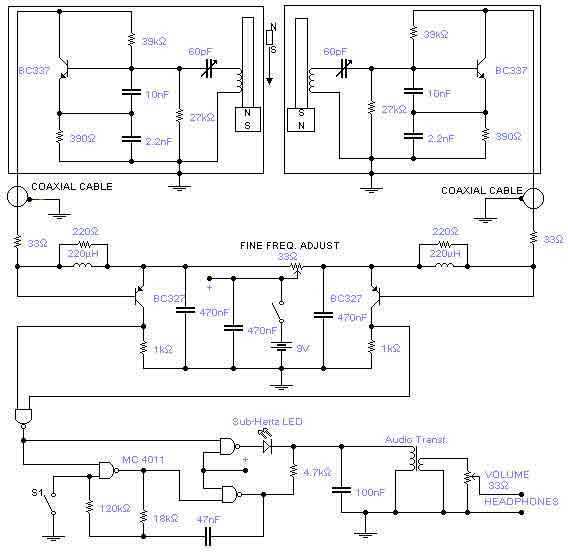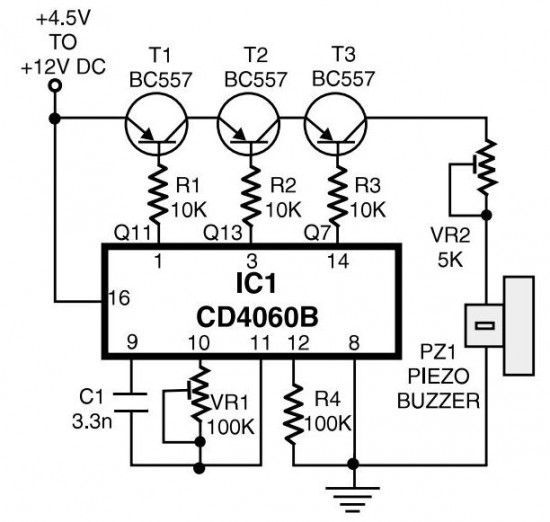
Head phone amplifier circuit

This is a simple headphone amplifier circuit designed to drive headphones when a music player lacks sufficient power. The circuit is straightforward and utilizes only three transistors. The first transistor, Q1 (BC 239), along with its associated components, functions as a preamplifier. The transistor pair Q2 and Q3 (BC 337 and BC 327) constitutes the driver circuit for the speaker, achieving power amplification at this stage. The emitter voltage of Q1 is fed back to the base of Q1 through resistor R3 to enhance performance and minimize distortion.
The headphone amplifier circuit operates by first amplifying the weak audio signal from the music player using the Q1 transistor. The BC 239 transistor is configured as a common emitter amplifier, which provides voltage gain. The input audio signal is applied to the base of Q1, and the amplified output is taken from the collector. The feedback mechanism through resistor R3 is crucial as it stabilizes the gain and reduces harmonic distortion, leading to a cleaner audio output.
Following the preamplification stage, the output signal is sent to the driver stage formed by Q2 and Q3 transistors. The BC 337 and BC 327 transistors are configured in a push-pull arrangement, allowing for efficient driving of the headphones. This configuration helps to deliver the necessary current to the headphones, ensuring that they are adequately powered for optimal sound reproduction.
The power supply for this circuit should be carefully selected to match the voltage requirements of the transistors, typically ranging from 9V to 12V. Proper bypass capacitors should be included to filter out any power supply noise, ensuring that the amplifier delivers a clean audio signal.
Overall, this headphone amplifier circuit is an effective solution for enhancing audio output from devices that may not provide sufficient power, utilizing a minimal number of components while achieving high performance.Here is a simple head phone amplifier circuit that can be used to drive your head phone if your music player doesn`t have enough power to drive your head phones. The circuit is straight forward and uses only three transistors. The transistor Q1 (BC 239) and associated components forms a pre amplifier. The transistor pairs Q2 & Q3 (BC 337 & BC 327) f orms the driver circuit for the speaker. Power amplification is attained at this stage. The emitter voltage of Q1 is fed back to base of Q1 via R3 in order to improve performance and reduce distortion. 🔗 External reference
The headphone amplifier circuit operates by first amplifying the weak audio signal from the music player using the Q1 transistor. The BC 239 transistor is configured as a common emitter amplifier, which provides voltage gain. The input audio signal is applied to the base of Q1, and the amplified output is taken from the collector. The feedback mechanism through resistor R3 is crucial as it stabilizes the gain and reduces harmonic distortion, leading to a cleaner audio output.
Following the preamplification stage, the output signal is sent to the driver stage formed by Q2 and Q3 transistors. The BC 337 and BC 327 transistors are configured in a push-pull arrangement, allowing for efficient driving of the headphones. This configuration helps to deliver the necessary current to the headphones, ensuring that they are adequately powered for optimal sound reproduction.
The power supply for this circuit should be carefully selected to match the voltage requirements of the transistors, typically ranging from 9V to 12V. Proper bypass capacitors should be included to filter out any power supply noise, ensuring that the amplifier delivers a clean audio signal.
Overall, this headphone amplifier circuit is an effective solution for enhancing audio output from devices that may not provide sufficient power, utilizing a minimal number of components while achieving high performance.Here is a simple head phone amplifier circuit that can be used to drive your head phone if your music player doesn`t have enough power to drive your head phones. The circuit is straight forward and uses only three transistors. The transistor Q1 (BC 239) and associated components forms a pre amplifier. The transistor pairs Q2 & Q3 (BC 337 & BC 327) f orms the driver circuit for the speaker. Power amplification is attained at this stage. The emitter voltage of Q1 is fed back to base of Q1 via R3 in order to improve performance and reduce distortion. 🔗 External reference
Warning: include(partials/cookie-banner.php): Failed to open stream: Permission denied in /var/www/html/nextgr/view-circuit.php on line 713
Warning: include(): Failed opening 'partials/cookie-banner.php' for inclusion (include_path='.:/usr/share/php') in /var/www/html/nextgr/view-circuit.php on line 713





